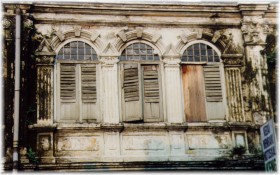
I remember that the Catholic nuns I had encountered in my parochial school days where invariably older and
would have had no physical attraction to me whether or not they were so
attired. I always thought nuns were either cloistered during their years
of beauty or only homely-looking women became nuns. This explains the dissimilarity
of Catholic nuns and Muslim Malay women we saw. Typically those wearing
veils, or tudungs in Malaysia were either school girls or young
women. To be sure the tudung and even more so the longer, more concealing
jilbab act in a certain way to de-sex a woman, but the less conservative
tudung, especially when worn with the colorful silk gown common
to Malaysia offers a sensuousness not often found amongst women who let their hair flow, fully exposed.
Call it a fetish if you must, but I found a tudung rather attractive
on young women in Malaysia (and in Indonesia as well). The tudung
acts as a frame for a woman's face. The clean lines, simple style, and
meticulously clean appearance of the tudung help to draw your attention
to the smooth beautiful skin of a woman's face. For better and for worse,
the tudung accentuates the demure side of a woman. I found myself
wanting to spend weeks just capturing images of a Malay woman's face as
it peered out of a tudung from different angles. It is not surprisingly
refreshing to find such a beauty in this era where it can be said that
a woman's soul is often revealed through her public attire, or lack of portions thereof, in the West.

|

Kuala Lumpur |

Kuala Lumpur began as a tin mining town inhabited mostly by Chinese in
the mid-nineteenth century. Until as late as 1830, most of the tin mining
in the larger state of Selangor was performed by Malays who mined tin part-time while subsisting
primarily on rice farming. At this time though, the face of tin mining in Selangor began to change.
New techniques for deeper mining of tin were
introduced, new areas further from Malay villages along the riversides
were opened for mining, and financing of the mines fell increasingly
in the hands of Chinese merchants in the Straits Settlements. By 1850,
the Malay tin industry was financed by Chinese, managed by Chinese, and Chinese
migrant labor was recruited by Chinese agents. Kuala Lumpur grew as a center
for the tin industry in the upper Kelang Valley. Merchant groups petitioned
the British to intervene to settle disorders along the West Coast of Malay
and British administration, ever desirous of supporting business which improved its own coffers, followed.
 Today,
KL, as Kuala Lumpur is affectionately termed, is a city developed with the
ambition of a newly independent nation too eager to shout out its competence. Ironically, Malaysians
conspicuously betray their incompetence in the construction that lays incongruently around and above the older city
that was constructed under the tutelage of the British. In my view, the beauty of KL still rests in
the colonial architecture, some simple, some more grand such as the railway
station, the Sultan Abdul Samad building, and the old city hall. The desire
to erase colonial architecture with newer, bigger, better construction
projects and its failure is no where more obvious than in the modern network
of expressways, a portion of which masks the elegant, old Moorish train station.
The much talked about twin towers and a structure that takes its inspiration
from the Seattle Sky Needle are more examples of this over-anxious desire
to prove the capabilities of Malaysians without careful consideration. Today,
KL, as Kuala Lumpur is affectionately termed, is a city developed with the
ambition of a newly independent nation too eager to shout out its competence. Ironically, Malaysians
conspicuously betray their incompetence in the construction that lays incongruently around and above the older city
that was constructed under the tutelage of the British. In my view, the beauty of KL still rests in
the colonial architecture, some simple, some more grand such as the railway
station, the Sultan Abdul Samad building, and the old city hall. The desire
to erase colonial architecture with newer, bigger, better construction
projects and its failure is no where more obvious than in the modern network
of expressways, a portion of which masks the elegant, old Moorish train station.
The much talked about twin towers and a structure that takes its inspiration
from the Seattle Sky Needle are more examples of this over-anxious desire
to prove the capabilities of Malaysians without careful consideration.
The real jewels of KL are often found off the main thoroughfares: a city block of restaurants
that opens out onto the sidewalks when tables are laid out at dusk for
dinner patrons who delight in some of Malaysia's finest cuisine without
pomp and ceremony; the small Indian section of town; outdoor markets; a
complex where pirated computer software is sold; streets where life thrives
around decaying edifices; an ornate mosque; bustling crowds of students
just released from the day's school session; and patrons at a group of
shopping complexes who spend more of their time acting out social rituals
than shopping.
In some ways KL is indicative of the diffused Straits Settlements area
of Western Peninsular Malaysia: Muslim Malay women, some of which were
dressed in kebaya (a long silk dress) covering their bodies and
sometimes a tudung (veil) covering their heads; some Chinese women
who, in sharp contrast, wore short skirts or tops that fitted tightly against
their breasts; and an Indian population also dressed in disparate ways,
but some of whom wore traditional cloths. It is a place that is still in
search of a comfortable identity: no longer a colony yet still coming to
terms with a stable, confident, forward-looking future.

|

Wau, Kelantan |
If you want to see what Baba (Straits
Chinese) culture has evolved into, go to Melaka. Travel to Singapore to see
similarities with Hong Kong. Explore the Indian enclaves of Singapore and
Kuala Lumpur and the Batu Caves to see how Hindu Indian culture is practiced
in Southeast Asia. If you want to see ethnic Malay Malaysia, go to
Kota Bharu. Kota Bharu, which is located in the farthest northeastern tip
of Malaysia near the border with Thailand, is strikingly different in this
regard from Western Peninsular Malaysia. Malaysian batik, traditional fashions,
Malaysian food, cultural sports and entertainment, and Malay Islamic culture
can all be seen here in a more authentic and rewarding manner than in the
commercial centers of Kuala Lumpur and Singapore.
|

